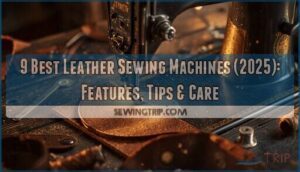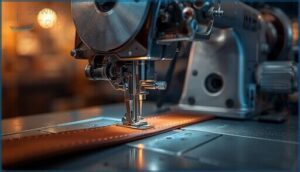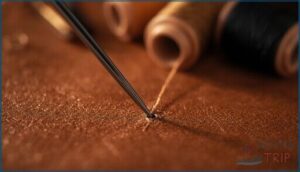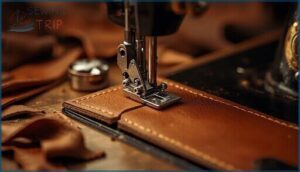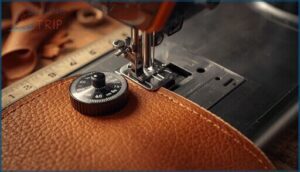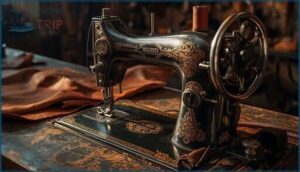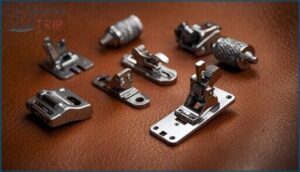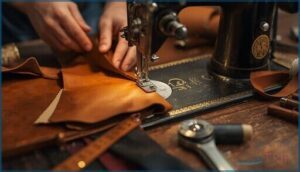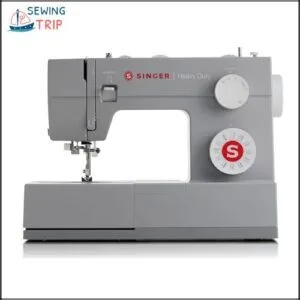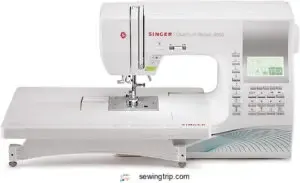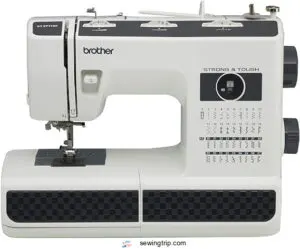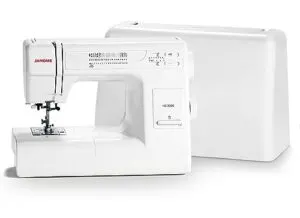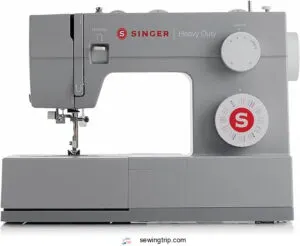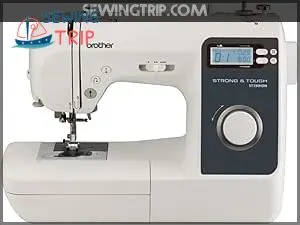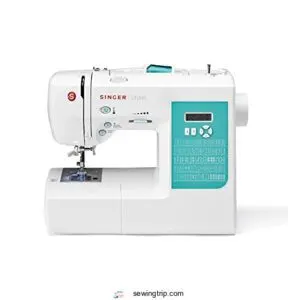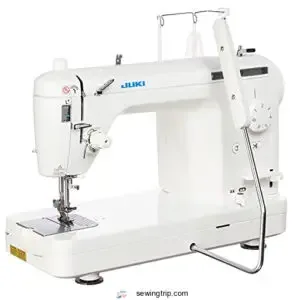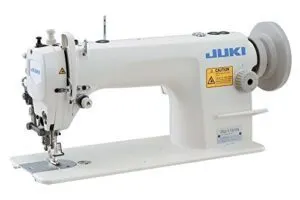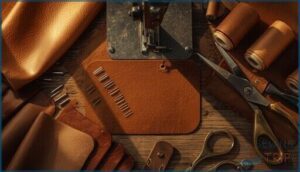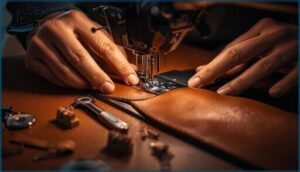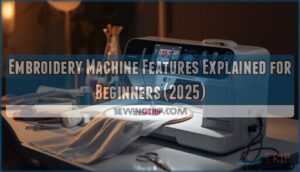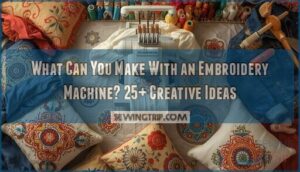This site is supported by our readers. We may earn a commission, at no cost to you, if you purchase through links.
Most sewing machines buckle when you feed them leather thicker than a belt. The motor whines, the needle bends, and your project becomes a frustrating mess of skipped stitches and broken thread. You need specialized equipment built to punch through heavy materials without flinching.
The best leather sewing machines pack powerful motors, reinforced feed mechanisms, and frames tough enough to handle saddles, holsters, and upholstery day after day. Whether you’re crafting wallets in your garage or running a custom leather shop, choosing the right machine means the difference between clean, professional seams and wasted materials.
Motor wattage, needle compatibility, and walking foot systems aren’t just specs—they’re what separate machines that conquer leather from those that surrender to it.
Table Of Contents
- Key Takeaways
- Key Features of Leather Sewing Machines
- Choosing The Right Leather Sewing Machine
- Top 9 Best Leather Sewing Machines
- 1. Singer Heavy Duty Sewing Machine 4423
- 2. Singer Quantum Stylist Sewing Machine
- 3. Brother Strong Tough Sewing Machine
- 4. Janome HD3000 Heavy Duty Sewing Machine
- 5. Singer Heavy Duty Sewing Machine 4432
- 6. Brother Heavy Duty Sewing Machine
- 7. Singer Stylist Sewing and Quilting Machine
- 8. Juki TL-2000Qi Sewing Quilting Machine
- 9. Industrial Top Feed Sewing Machine
- Essential Accessories for Leather Sewing
- Tips for Sewing Leather Successfully
- Maintenance and Care for Leather Sewing Machines
- Frequently Asked Questions (FAQs)
- Conclusion
Key Takeaways
- Motor power (550+ watts), needle compatibility (90/14 to 110/18), and walking foot mechanisms separate machines that handle thick leather from those that stall mid-project.
- Industrial machines deliver 5x the speed of domestic models (up to 5,000 stitches per minute) and handle 8-16 oz leather, while domestic machines max out around 1.4mm thickness for occasional wallet and pouch work.
- Essential accessories like diamond-tipped needles, bonded polyester thread (Tex 135-210+), and Teflon or roller feet prevent the surface damage, thread breakage, and feed issues that wreck leather projects.
- Regular maintenance—oiling every 8-10 hours, replacing needles after 8 hours of leather work, and storing in climate-controlled spaces with 40-60% humidity—cuts breakdowns by 45% and doubles machine lifespan.
Key Features of Leather Sewing Machines
Not every sewing machine can manage leather—you need specific features that turn a standard setup into a leather-working powerhouse. The difference between struggling through a project and nailing it comes down to motor strength, feed mechanisms, and how well the machine manages thick materials.
Here’s what separates machines that can tackle leather from those that’ll leave you frustrated.
Motor Power and Type
Motor power and type determine whether you’ll breeze through thick leather or stall mid-project. Industrial sewing machines usually run on 430–550-watt motors—clutch systems for nonstop power or servo motors for energy consumption that’s 70% lower.
Brushless servo motors deliver precision at slow speeds with high torque, while direct-drive designs boost motor efficiency by eliminating belts.
Your heavyduty motor choice shapes everything from power output to your electricity bill. Considering the energy efficient options is essential for reducing costs and improving overall performance.
Needle and Thread Compatibility
Once you’ve nailed down motor power, needle compatibility becomes your next make-or-break decision. Leather needles range from 90/14 for lightweight hides to 110/18 or larger for heavy materials, while thread materials like polyester, nylon, and waxed polyester handle different thicknesses.
Pairing the right needle sizes with thread compatibility prevents breakage and skipped stitches—mismatched combos wreck stitch quality and damage the leather thickness you’re working with. To achieve ideal results, consider the thread size guidelines for your specific leather project.
Presser Foot and Feed Mechanism
Your feed mechanism matters just as much as needle choice—it’s what keeps layers from shifting mid-seam. Walking foot mechanisms synchronize the needle, presser foot, and feed dog to move everything together, delivering stitch consistency that drop-feed machines can’t match.
Adjustable presser foot pressure lets you dial in the grip for different leather thicknesses, while roller feet benefits include smooth feeding without surface marking.
Stitch Length and Adjustment Options
Controlling your stitch length directly impacts seam strength and appearance. For leather, adjustments between 3.0–4.0 mm are ideal—shorter lengths risk excessive perforation, while longer stitches maintain material integrity. Modern machines offer digital stitching precision with 0.1 mm increments, though mechanical dials work fine for most projects.
- Adjustment mechanisms range from simple levers to digital control panels for instant stitch length changes
- Precision sewing depends on consistent stitch quality across varying leather thickness
- Stitch control options let you match stitch types to your project’s structural needs
Durability and Build Quality
You can’t cut corners when your machine needs to handle thick leather day after day. Metal frames outlast mixed-material models by over a decade, with all-metal construction cutting mechanical failures by 30%.
Heavy-duty sewing machines with cast-iron bodies and hardened steel gears deliver consistent stress handling and wear resistance.
That durable construction translates to real cost efficiency—industrial models retain 60% resale value after ten years.
Specialty Feet and Accessories
The best leather sewing machine accessories transform your stitching results. Teflon and roller feet prevent surface scuffing by 40%, while walking feet cut puckering by 32%. Knurled feed dog types grip textured leather without slippage, and slotted needle plate variety allows 0.2 mm stitch precision.
Complete accessory kit value runs $75–$125, with attachment installation taking under two minutes on modern machines.
Choosing The Right Leather Sewing Machine
Picking the right leather sewing machine isn’t about grabbing the most expensive model or the one with the flashiest features. You need to match the machine’s capabilities to your specific projects, whether you’re stitching wallet leather or tackling heavy-duty saddle work.
Let’s break down the key factors that’ll help you make a smart choice.
Domestic Vs Industrial Machines
You’ll face a critical fork in the road when choosing between domestic vs industrial machines for leather work. Industrial sewing machines deliver speeds up to 5,000 stitches per minute—five times faster than domestic models—and feature cast iron frames with serious motor differences that handle multi-layer heavy leather without breaking a sweat.
Speed comparison reveals domestic machines max out near 800 stitches per minute, suitable for occasional projects, while needle compatibility and build quality favor industrial options for professional results.
Cost analysis shows industrial models run $500-$2,000, but their durability pays off long-term.
Project Types and Leather Thickness
Matching your leather sewing machine to project types and leather thickness separates successful makers from frustrated ones. Thin garment leather (2–4 oz) needs different handling than tooling weight (8–10 oz) or armor-grade hides (10–12 oz).
Here’s how thickness impact drives material selection:
- Domestic machines handle up to 1.4 mm (3.5 oz)—wallets and pouches only
- Medium projects require 4–6 oz leather for bags and belts
- Heavy-duty work demands industrial machines for 8–16 oz leatherworking
Evaluating Machine Specifications
You need five core sewing machine specifications before committing: motor wattage (aim for 550 watts minimum), needle compatibility (system 130/705 H LL accommodates 90/14 to 110/18 sizes), foot clearance (9/16 inch accommodates stacked layers), stitch options (3–22 stitches per inch), and build materials (all-metal frames outlast plastic).
These motor power and type, presser foot and feed mechanism, and needle and thread compatibility details determine whether your machine masters thick leather or chokes on it.
Budget Considerations
Leather sewing machines range from $200 domestic models to $7,000+ industrial powerhouses, and that gap isn’t just marketing hype. Budget strategies matter: allocate product pricing to cover machine depreciation, especially since leather work accelerates wear.
Domestic machines under $500 handle lightweight projects, while industrial options starting at $1,000 deliver durability for heavy-duty work.
Cost influences include motor strength, presser foot lift, and metal frame construction—essentials that justify higher prices.
User Experience and Ease of Use
Price tags don’t tell the whole story—operator comfort shapes your long-term success. Ergonomic design matters when 86% of leather workers report low back pain. Focus on:
- Automatic needle threading that eliminates eye strain
- Speed reducers (44-412 stitches/minute) for beginner-friendly control
- User interface simplicity that shortens your learning curve
- Adjustable presser foot pressure for workflow efficiency
Easy-to-use sewing machines minimize fatigue while maximizing output.
Top 9 Best Leather Sewing Machines
You’ve narrowed down your needs—now it’s time to see which machines actually deliver. The right leather sewing machine balances motor power, feed strength, and build quality without breaking your budget.
Here are nine proven options that can handle everything from lightweight garment leather to thick upholstery and saddle work.
1. Singer Heavy Duty Sewing Machine 4423
The Singer 4423 brings serious muscle to your leather sewing machine lineup with a motor that’s 60% stronger than standard domestic models. You’ll push through thick hides at 1,100 stitches per minute—that’s power you can feel.
This heavy-duty workhorse manages leather projects without breaking a sweat, thanks to its metal frame and adjustable stitch length up to 4mm. The Singer Machine accepts needles up to 110/18 size, perfect for heavyweight materials.
At 14.5 pounds, it’s built to last a decade with proper care, making it a solid investment for serious craftwork.
Best For: Sewers tackling heavy fabrics like leather, denim, and canvas who need a durable machine that can handle thick layers without slowing down.
- Motor delivers 60% more power than standard machines, pushing through leather at 1,100 stitches per minute without jamming or skipped stitches.
- Metal frame and stainless steel bedplate provide rock-solid stability during high-speed work, with a build quality rated to last over 10 years.
- Accepts heavy-duty needles up to 110/18 size and adjusts stitch length to 4mm, giving you the flexibility to work with multiple leather thicknesses and tough materials.
- At 14.5 pounds, it’s noticeably heavier than typical home machines, making it less portable for classes or travel projects.
- Some users report bobbin tension issues and thread tangling if the machine isn’t threaded carefully, requiring patience during setup.
- Limited authorized repair centers and mixed reviews on durability suggest potential service headaches if problems arise outside the warranty period.
2. Singer Quantum Stylist Sewing Machine
If versatility matters more than raw power for your leather projects, the Singer 9960 Quantum Stylist delivers 600 built-in stitches while still handling medium-weight leather at 850 stitches per minute.
This computerized heavy-duty machine includes a walking foot among its 19 Stylist Accessories, giving you smooth feeding through thick materials without the industrial price tag.
The adjustable stitch length maxes out at 5mm, and its automatic needle threader saves you time when switching between heavy needles. At 25 pounds, it’s stable enough for serious sewing leather work.
Best For: Sewers who want professional stitch variety and computerized controls for medium-weight leather projects without investing in an industrial machine.
- 600 built-in stitches with LCD controls give you creative flexibility for decorative leather work alongside functional seams.
- Comes with 19 presser feet including a walking foot, so you can handle thick materials right out of the box.
- Automatic needle threader and drop-in bobbin system cut down setup time when switching between different leather projects.
- Some users report the automatic needle threader can be finicky and may not work consistently with heavier needles.
- At 850 stitches per minute, it’s slower than dedicated leather machines, which can frustrate you on large projects.
- Feed dogs and stitch quality can be inconsistent on thicker leather, requiring manual adjustments and patience.
3. Brother Strong Tough Sewing Machine
For three layers of leather at 800 stitches per minute, the Brother ST371HD manages heavyweight material with a metal needle plate that won’t flex under pressure. You get 37 stitches, including auto-buttonholes, plus an automatic needle threader that works with size 14 needles designed for leather thickness.
The Brother HC1850 also qualifies as a heavy-duty option, but the ST371HD’s free arm makes cylindrical projects like belts easier. At 18.4 pounds, this heavy-duty sewing machine stays planted when pushing thick hides through.
Best For: Sewers who need a workhorse machine that can power through thick leather, denim, and heavy outdoor fabrics without bogging down.
- Handles up to three layers of leather at 800 stitches per minute thanks to a metal needle plate and heavyweight needles designed for thick materials.
- Free arm design makes cylindrical projects like belts and cuffs much easier to manage than flat-bed-only machines.
- Automatic needle threader saves time and frustration when working with size 14 needles on demanding projects.
- Mixed reviews mention stitch quality issues and threading problems that can disrupt workflow mid-project.
- Customer support is hard to reach, and warranty claims can be a hassle if something goes wrong.
- Some users report the machine stopping or malfunctioning unexpectedly, especially after extended use.
4. Janome HD3000 Heavy Duty Sewing Machine
The Janome HD3000 delivers 860 stitches per minute through a die-cast aluminum frame that won’t vibrate when you’re pushing thick hides through. You get adjustable presser foot pressure and an extra-high lift that clears bulky seams without a fight.
The five-piece feed dog system grips leather consistently, while 18 built-in stitches handle utility work and decorative touches.
At $529 and 21 pounds, this heavy-duty machine maintains tension automatically across varying thicknesses, making it reliable for both daily leather projects and occasional upholstery work.
Best For: Sewers who need a reliable workhorse for heavy fabrics like leather, denim, and upholstery without spending over $1,000.
- Handles thick materials effortlessly with 860 stitches per minute and adjustable presser foot pressure that actually works.
- Built like a tank with a die-cast aluminum frame that stays stable during heavy-duty projects.
- Easy to use right out of the box with automatic needle threader and snap-on presser feet.
- No speed control feature, so you’re relying entirely on foot pedal finesse for slower work.
- Shorter power and pedal cords might have you hunting for extension cords depending on your workspace.
- Manual tension adjustment can feel fiddly if you’re switching between very different fabric weights often.
5. Singer Heavy Duty Sewing Machine 4432
With 1,100 stitches per minute and 60% more motor power than standard machines, the Singer 4432 plows through multiple leather layers without hesitation. You’ll appreciate the metal frame and adjustable presser foot pressure during heavy-duty sewing machine work—they keep thick hides moving smoothly at speed.
The 32 built-in stitches and 6mm stitch width give you flexibility for decorative leatherwork, while the automatic buttonhole and drop-in bobbin cut setup time.
At around $200, this Singer Heavy Duty delivers reliable leather stitching with a 25-year warranty backing your investment.
Best For: Sewers who need a workhorse machine for leather, denim, and canvas projects without spending over $300.
- Speed and power combo (1,100 stitches/min, 60% stronger motor) handles thick leather and multiple layers without jamming or slowing down.
- Metal frame and adjustable foot pressure keep heavy materials moving smoothly, plus 32 stitch options give you room for decorative work.
- Strong warranty coverage (25 years on the head, 2 years on motor) backs up the durability claims at this price point.
- Needle threader fails frequently according to customer reports, which can get frustrating during longer sewing sessions.
- Power switch and feed lever sit below the work surface, making them hard to reach if you mount the machine in a cabinet.
- Some users report durability issues and early breakdowns despite the heavy-duty label, with mixed long-term reliability feedback.
6. Brother Heavy Duty Sewing Machine
Brother’s ST371HD combines 850 stitches per minute with a metal interior frame that stays rock-solid when you’re pushing thick leather through. The machine manages heavyweight fabrics and multiple layers without the wobble or motor strain that kills momentum on lighter models.
You get 50 built-in stitches, a walking foot for even leather feeding, and adjustable presser foot pressure that accommodates your material thickness. The nonstick foot glides over sticky surfaces while the drop-in bobbin resists jamming.
At under $200 with a 25-year warranty, this Brother Heavy Duty punches above its weight class.
Best For: Home sewers and hobbyists tackling leather projects, denim repairs, and thick fabric work who need serious stitching power without the industrial price tag.
- Metal frame construction keeps the machine stable through heavy materials—no walking across your table mid-seam.
- 850 stitches per minute with adjustable presser foot pressure means you control the speed and handling for different leather thicknesses.
- Includes specialized feet like the walking foot and nonstick foot that actually make leather feeding smooth instead of a wrestling match.
- Presser foot lift height can struggle with extremely thick leather stacks—you might need to finesse bulky seams.
- Threading sensitivity means you’ll want to follow the manual closely or risk skipped stitches and tension headaches.
- 120-volt US-only design limits international use and voids warranty if you try to work around it.
7. Singer Stylist Sewing and Quilting Machine
Singer’s 9960 Quantum Stylist brings 600 built-in stitches and a metal frame that manages lightweight to medium-weight leather with ease. You’re looking at 850 stitches per minute, 18 presser feet (including a walking foot), and adjustable presser foot pressure that caters to your leather projects.
The extension table stabilizes larger pieces while the automatic needle threader cuts setup time. This leather sewing machine excels at bags and accessories when paired with proper needles—though thicker hides may challenge it.
At this price point, the accessory options and quilting features make it a solid choice for expanding your sewing techniques beyond heavyweight basics.
Best For: Sewers who want to tackle light to medium-weight leather projects like bags and wallets while keeping quilting and decorative stitching options open.
- 600 built-in stitches and 18 presser feet give you serious creative range, from basic leather work to detailed monogramming and quilting.
- Metal frame and 850 stitches per minute keep things stable and fast, even when you’re working through multiple layers or larger pieces on the extension table.
- Automatic needle threader and visible drop-in bobbin cut down on setup frustration, so you spend more time sewing and less time threading.
- Struggles with thick or hard leather—you’ll need to stick with thinner materials or risk skipped stitches and uneven feeding.
- Some plastic components like the presser foot handle may wear down faster than you’d expect, especially with frequent use.
- North America-only power supply limits where you can use it, and the machine isn’t built for heavy-duty industrial tasks.
8. Juki TL-2000Qi Sewing Quilting Machine
The Juki TL2000Qi stands as a semi-industrial powerhouse built for serious leather sewing machine work. Its Juki motor pushes 1,500 stitches per minute with quilting speed that manages heavyweight materials without hesitation.
You’ll appreciate the aluminum die-cast construction for machine durability, while the adjustable 6mm leather stitch length prevents perforation—critical for sewing precision on thick hides.
The automatic thread cutter and knee lifter simplify heavy-duty sewing machine operations. Though pricier than domestic models, this Juki TL2010Q alternative delivers consistent performance on demanding leather projects.
Best For: Quilters and sewers who need industrial-strength performance for heavy fabrics, leather work, and large projects like king-size quilts, but want a machine that’s still manageable for home use.
- Powerful 1,500 SPM motor handles thick materials like leather, denim, and multiple quilt layers without slowing down or skipping stitches.
- Aluminum die-cast construction keeps vibration low and ensures the machine stays stable even at high speeds, which means cleaner stitch lines.
- Includes practical features like an automatic thread cutter, knee lifter, and extension table that make working on big projects much easier.
- Only does straight stitching, so if you need decorative or zigzag stitches, you’ll need a different machine.
- The automatic needle threader can be temperamental and might need tweaking to work consistently.
- Bobbin area is awkward to reach, which can be frustrating if you have limited hand mobility or arthritis.
9. Industrial Top Feed Sewing Machine
When you’re ready to move beyond domestic limits, the JUKI DU-1181N delivers true industrial sewing power for serious leather crafting. This industrial sewing machine roars through medium to heavyweight materials at 2,000 stitches per minute—speeds no household model can touch.
Its top feed mechanism pulls thick hides smoothly, while the 9mm stitch length manages demanding projects like saddles and holsters.
At 229 pounds with a clutch motor, this heavy-duty workhorse represents genuine sewing automation for professional leather work. Assembly takes effort, but the performance justifies it.
Best For: Professional leather crafters and small manufacturing operations who need to sew heavy materials fast and can handle industrial setup and noise.
- Blazing 2,000 stitches per minute speed cuts production time dramatically compared to home machines.
- Top and bottom feed system grabs thick leather reliably, preventing slipping and uneven stitches.
- Built like a tank at 229 pounds with industrial components designed for years of heavy daily use.
- Assembly is challenging with no instructions included, and customer support is reportedly hard to reach.
- Clutch motor runs loud—this is a workshop machine, not something for a quiet home studio.
- Table and legs often arrive with cosmetic scratches and dings from the manufacturing process.
Essential Accessories for Leather Sewing
Even the best leather sewing machine won’t perform at its peak without the right accessories backing it up. You’ll need specialized tools that can handle leather’s unique demands—from needles that won’t snap to feet that glide smoothly over thick hides.
Here’s what you should have in your toolkit to turn good results into professional-grade work.
Leather Sewing Needles
You’ll want the right leather needles for your leather sewing machine. Diamond-tipped DI needles work best for thick, firm leather, while blunt-point needles prevent thread piercing during hand stitching. Round point needles suit softer leather.
High-carbon steel construction ensures needle durability, and titanium-coated options reduce friction by over 20%. Match needle size to leather thickness and thread compatibility for best leather stitching results.
Heavy-Duty Threads
Your leather needles need the right partner. Polyester and nylon threads dominate heavy-duty leather stitching, accounting for over 80% of professional applications. Thread compatibility with your leather sewing machine matters—Tex 135 for medium-weight projects, Tex 210+ for industrial applications like saddlery.
- Bonded polyester delivers tensile strength up to 900 MPa for load-bearing seams
- Waxed thread prevents fraying in hand-sewn luxury goods
- Size matching ensures proper needle penetration without large holes
Walking, Roller, and Teflon Feet
Your presser foot choice transforms how leather moves through your machine. Walking foot mechanisms cut fabric shifting by 87% in multi-layer assemblies—they’re in 65% of industrial setups for good reason.
Roller feet excel on curves, reducing feed resistance by 60% on sticky materials. Teflon feet prevent drag on vinyl and patent leather, lowering surface damage by 45%.
Match the foot to your leather thickness and project demands.
Stronger Feed Dogs
Feed dogs built from hardened steel alloys—above 50 HRC—grip thick leather without slipping. Standard feed dogs can’t handle the demands of heavy-duty materials, but upgrading to industrial-grade models with knurled surfaces boosts grip efficiency by 30%.
Your leather sewing machine performs better with feed mechanism upgrades designed for adjustable presser foot pressure.
Proper feed dog maintenance every 150 hours keeps feeding efficiency above 98% and extends component life by 44%.
Adjustable Stitch Length Tools
Precision sewing demands control over every seam. Modern leather sewing machines measure stitch length in millimeters, usually adjustable from 1 mm to 8 mm. Your adjustable stitch length tools deliver stitch quality customized to leather thickness:
- Mechanical dials offer 0.5 mm increments for exact calibration
- Digital controls provide programmable patterns for complex projects
- Thumbscrews enable real-time, tool-free stitch length adjustment
- Spring-loaded levers maintain consistency across varying thicknesses
Longer stitches—8 to 10 SPI—prevent material perforation when handling thick layers.
Waxed Thread and Specialty Clips
Professional stitching starts with waxed thread—polyester or linen varieties resist fraying up to 40% longer and deliver tensile strengths around 15 pounds per strand. Pair it with specialty clips that won’t mar your leather’s surface.
Proper thread tension and clip placement within seam allowances prevent visible indentations. Your leather sewing machine benefits from needle and thread compatibility, ensuring stitch reinforcement and excellent leather finishing on every project.
Tips for Sewing Leather Successfully
Sewing leather isn’t like working with fabric—it demands different techniques and a bit of finesse to get professional results. You’ll need to adjust your approach from preparation to stitching if you want clean seams and long-lasting projects.
Here’s what you need to know to handle leather like a pro.
Preparing Leather for Sewing
Getting the leather ready before you feed it into your leather sewing machine makes or breaks your leather projects. Surface hygiene matters—wipe down with mild soap and let it dry completely to avoid presser foot marks. Material preparation sets you up for clean leather stitching and professional results.
- Leather cleaning with gentle soap removes grime without stripping natural oils, keeping flexibility intact for sewing leather
- Edge skiving cuts seam bulk by 40%, making leather stitching smoother on any machine
- Leather conditioning boosts malleability by 60%, preventing thread breaks and cracking during your leather projects
Using Clips or Tape Instead of Pins
Pins punch permanent holes in leather, leading to a 93% rejection rate in finished goods. Switch to fabric clips for pinless sewing; they hold up to four layers without damaging the leather.
Fabric clips replace pins for leather sewing—pins leave permanent holes that ruin 93% of finished goods
Double-sided tape works even better, cutting seam puckering by 28% and speeding up leather projects by 31%. Your leather sewing machine runs smoother, and you’ll protect every surface while mastering professional leather stitching techniques.
Adjusting Tension and Stitch Length
Your tension control and stitch length adjustment can make or break a leather seam. Test both settings on scrap pieces before starting your project, then adjust based on these guidelines:
- Tension Control: Set between 3 and 6, lowering for thicker leather thickness and raising for lighter materials to prevent thread loops.
- Stitch Optimization: Use 3-4 mm for general sewing calibration, 5-6 mm for heavy-duty work to minimize perforation.
- Thread Settings: Recalibrate when switching thread brands or needle sizes to maintain balanced stitches.
- Testing Protocol: Lower your presser foot before making tension adjustments for proper disk engagement.
Adjustable stitch length features let you fine-tune in 0.5 mm increments on computerized models, ensuring ideal stitch types for sewing leather successfully.
Avoiding Common Mistakes
Want to skip the headaches? Five mistakes cause most leather sewing problems, but you can dodge them all with smart preparation.
| Mistake | Prevention Strategy |
|---|---|
| Thread Breakage (37% of cases from mismatched sizes) | Match needle gauge to thread weight; use heavy-duty machine threads |
| Skipped Stitches (48% higher with standard needles) | Install leather needles with cutting points designed for dense materials |
| Material Deformation (39% from excess pressure) | Reduce presser foot tension; test on scraps first |
| Stitch Inconsistency (26% from thread mismatches) | Use identical top and bobbin threads with proper stitch length settings |
| Presser Foot Issues (53% leave marks) | Switch to smooth or knurled feet instead of aggressive sawtooth designs |
Test every adjustment on scrap leather before touching your project—broken needles and wavy seams aren’t reversible.
Maintenance and Care for Leather Sewing Machines
Your leather sewing machine is built like a tank, but it won’t stay that way without proper attention. Even the toughest machines need regular care to maintain their power and precision through hundreds of projects.
Here’s what you need to do to keep your machine running strong for years.
Regular Cleaning and Oiling
Every eight to ten hours of heavy use, you’ll want to drop one or two drops of light sewing machine oil on all marked points—this keeps your leather sewing machine running smoothly and cuts breakdowns by 45%.
Regular cleaning schedules prevent lint buildup that spikes maintenance costs by 60%. Proper machine lubrication doubles your machine’s lifespan while boosting sewing efficiency through consistent stitch quality.
Replacing Needles and Threads
Beyond regular oiling, you need to swap out your sewing needle after eight hours of leather work—worn needles spike thread breakage and wreck stitch quality. Leather needles lose their edge fast, causing leather damage you won’t see until it’s too late.
Change them between projects, match your thread thickness to the leather, and inspect for bends after any snag. Fresh needles mean stronger seams.
Storing The Machine Properly
Proper storage isn’t just about finding shelf space—it’s machine preservation that keeps your investment running strong. You need climate control with humidity management between 40% and 60%, plus dust protection using breathable covers that block 85% of particles. Keep your machine off concrete floors, away from sunlight, and in low-traffic zones. Storage solutions that prioritize these factors cut mechanical failures by nearly half.
- Store in climate-controlled rooms to prevent component stiffness and mold growth
- Cover with breathable cloth instead of plastic to block dust while allowing airflow
- Place machines on dedicated surfaces, not directly on concrete or metal
- Monitor humidity levels regularly—staying between 40-60% protects both machine and leather
Following Manufacturer Maintenance Guidelines
Your manufacturer’s maintenance manual is the blueprint for machine longevity. Scheduled maintenance and preventive care aren’t optional if you’re serious about warranty compliance and performance.
Following lubrication schedules cuts downtime by 20% and extends your machine’s life by five years. Ignoring these guidelines? You’re looking at 30% higher operating costs.
Stick to the schedule, document everything, and you’ll keep your sewing machine for leather running like new.
Troubleshooting Common Issues
When thread breakage or needle damage strikes mid-project, you’ll need quick fixes to keep working. Check your stitch length first—wrong settings cause 36% of skip rates on layered leather.
- Adjust presser foot pressure to prevent fabric slippage and skipped stitches
- Replace broken needles immediately; cutting-point types reduce heat damage by 25%
- Monitor motor overheat during extended runs on heavyduty projects
- Verify thread tension matches your needle size for sewing leather successfully
Frequently Asked Questions (FAQs)
How do I maintain a leather sewing machine?
Clean your leather sewing machine after every use, removing lint from bobbin and feed dog areas.
Oil industrial models every 7–8 hours of operation.
Replace needles frequently and store in a dry location.
Can I upgrade components for thicker leather?
Yes, you can upgrade leather sewing machines with servo conversion, needle modifications, and stronger feed dogs. These motor upgrades and feed mechanism enhancements handle increased leather thickness on heavy-duty fabrics with adjustable presser foot pressure.
What are common leather sewing machine issues?
Over two-thirds of service calls trace back to thread tension problems. You’ll face needle jamming, broken needles, motor strain, feed issues, skipped stitches, and thread breakage—all preventable with proper stitch length adjustment and routine maintenance.
How does leather type affect machine performance?
Full-grain leather demands higher motor torque and specialized needles due to dense fibers, while split and bonded leather types require less power.
Leather thickness directly impacts material handling, seam strength, and heavyduty sewing machines performance in leatherwork.
Are there eco-friendly leather sewing machines?
You’ll find eco-friendly machines featuring servo motors that cut energy use by 30% and digital controls reducing waste.
Sustainable materials, recyclable metals, and green technology now drive heavy-duty leather sewing innovation forward.
Can I sew leather by hand instead?
You can hand sew leather using techniques like saddle stitching with tapestry needles and waxed thread. Hand tool options deliver durability, but sewing speed comparison shows machines finish leather projects faster than manual leather stitching.
What thread weight works best for leather?
Thread selection works like choosing the right rope for the job—your leather thickness guides the decision.
For thin leather, use Tex 70 bonded nylon. Medium-weight projects need Tex 92, while heavy-duty sewing demands Tex 135 or thicker thread for material strength and stitch quality.
How do I prevent leather from sticking?
Use specialty presser foot options like Teflon or walking foot to reduce friction. Adjust stitch length to 5mm and decrease foot pressure.
Apply silicone spray on the plate for smooth leather feeding.
Do I need special bobbins for leather?
Like choosing the right wrench for a stubborn bolt, your bobbin matters.
Metal bobbins work best for leather sewing machines—they handle thread tension and leather thickness better than plastic, boosting sewing efficiency on heavy duty projects.
Can leather sewing machines handle suede too?
Most leather sewing machines handle suede well with proper adjustments. Suede compatibility depends on leather thickness and material handling.
You’ll need machine adjustments like longer stitches, walking feet, and lower tension to prevent suede seam tearing.
Conclusion
Think of leather as the supreme test: it either exposes a machine’s weaknesses or proves its worth. The best leather sewing machines don’t compromise—they deliver power, precision, and reliability when you need clean seams through tough materials.
Armed with the right specs, accessories, and maintenance habits, you’ll transform raw hides into professional work that lasts. Your next project deserves equipment that won’t back down when the leather gets thick.
- https://www.goldstartool.com/blog/5-questions-to-ask-before-purchasing-a-heavy-duty-sewing-machine.htm
- https://www.weaverleathersupply.com/products/550-watt-servo-motor
- https://sewingmachineman.substack.com/p/calculating-the-power-of-a-sewing
- https://leatherworker.net/forum/topic/97167-34-or-1-horse-power-servo-motor/
- https://infinitysewing.co.uk/direct-drive-vs-clutch-motor-machines-which-is-best/

